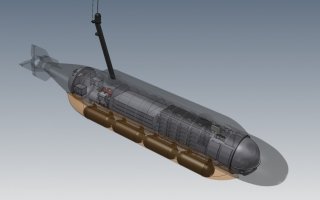Hell Yes: Submarine Drones Are Coming to Britain's Royal Navy
The Royal Navy is joining the U.S. Navy in the XLUUV club, which is pursuing XLUUV designs from both Lockheed Martin and Boeing.
Here's What You Need to Know: The future is now.
In March 2020, the British Royal Navy announced awarding a contract for an unmanned submarine—a drone—that will be 30 meters long, or about 100 feet, and have a 3,000 kilometer—1,900 mile —range. The builder, Submergence Group & M Subs Ltd are based in the UK and Texas.
The Extra Large Unmanned Underwater Vehicle, or XLUUV ‘Manta’ as it is also known, weighs a slight 8.9 tons, can dive to 305 meters, and is intended for short-term missions under 48 hours, according to a company website. The Manta’s propulsion is provided by “advanced motor technology to directly drive the main propeller,” which could mean a diesel-electric or air-independent propulsion system.
Development was quite accelerated, the time from prototype to final product took a startlingly fast 14 months. Given the size of the Manta, it may likely stick to littoral, or costal operations, rather than the deepwater missions larger manned submarines are capable of. (Although the small hull detentions could be indicative of its role as a technology demonstrator rather than a finalized design.) The Manta is based on the company’s previous MORAY unmanned submarine, which is significantly larger, at about 77 tons.
In a press release, First Sea Lord Admiral Tony Radakin stated that 2019 was a busy year for the Royal Navy. “In 2019 we saw the highest Russian activity in the North Atlantic for over 30 years. Submarines are getting quieter, more capable and harder to detect.” The Manta, which will eventually be armed, is intended to augment the Royal Navy’s submarine force.
The Royal Navy is joining the U.S. Navy in the XLUUV club, which is pursuing XLUUV designs from both Lockheed Martin and Boeing. While just building underwater UUVs is not so hard, improving doctrine and tactics is. Being an early part of the underwater drone scene will allow the U.K. to be ahead of the curve when it comes to working out inevitable kinks in the design. Still, some challenges remain.
It is unclear how the XLUUVs will communicate with the surface. Underwater signal transmission suffers from a number of complicating factors, so keeping a man-in-the-loop like how airborne drones are commanded may be difficult—and begs the question, once armed, will XLUUVs pull the trigger on targets themselves?
Radakin ended on a positive note, stating “There is a great deal going on here. But I am confident that we are heading in the right direction, pursuing modern solutions, modern ways of working, delivering solutions to traditional problems in a modern way.” In a nod to increasingly mature naval technology, he said, “we will continue to evolve, both nationally and in company with our allies.”
Caleb Larson holds a Master of Public Policy degree from the Willy Brandt School of Public Policy. He lives in Berlin and writes on U.S. and Russian foreign and defense policy, German politics, and culture.
This article first appeared in May 2020.
Image: MSubs

